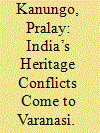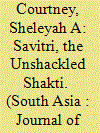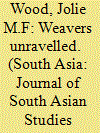|
|
|
Sort Order |
|
|
|
Items / Page
|
|
|
|
|
|
|
| Srl | Item |
| 1 |
ID:
186045


|
|
|
|
|
| Summary/Abstract |
The idea of “dominant caste” has been important in the discourse of caste that saw the movement from social intercourse (hierarchy, purity-pollution) to political mediation (representation, demand for positive discrimination) in various literature. This paper offers a longitudinal study of caste relations in and around Varanasi in North India, focusing on the Brahmin caste vis-à-vis another dominant caste (non-Brahmin). It combines historical material with individual-level data set, the findings of which are presented as a case study. The essay’s objectives are as follows (a) description and analysis of two different “dominant” castes to understand the functioning of the caste identity in contemporary India. This is done to reevaluate how the castes have sought to convert their historically accrued caste capital into social or political capital; (b) the relationship between the two “dominant” castes. It was found that dominance was regionally located in both cases, but in the colonial period, it depended on caste hierarchy, unlike in post-colonial/modern days. This recreated a sort of discrimination manipulated by the dominant castes at their respective levels.
|
|
|
|
|
|
|
|
|
|
|
|
|
|
|
|
| 2 |
ID:
189717


|
|
|
|
|
| Summary/Abstract |
India’s ruling Hindu nationalist party is pursuing a campaign to revise history and remove historic Islamic monuments from cities like Varanasi, known for its multicultural fabric.
|
|
|
|
|
|
|
|
|
|
|
|
|
|
|
|
| 3 |
ID:
131905


|
|
|
|
|
| Publication |
2014.
|
| Summary/Abstract |
In Hindu cosmology and life-worlds, women are described as being Shaktis, personifications of cosmic feminine power or shakti. However, the shakti of Hindu widows of all ages, because it is no longer directed into reproduction, is feared as being rampant, likely to incur disgrace, polluting and dangerous. Hence, widows, deemed culpable of having failed in their primary wifely duty of protecting and preserving the health and lives of their husbands, are often ill-treated in an attempt to weaken and disarm the reservoir of power that they continue to embody. This article focuses on a case study of a young widow, Savitri, who strove to support her children and maintain her self-regard in the face of frequently-violent hostility from her neighbours due to her creative yet subversive circumvention of the religio-cultural prescriptions and proscriptions her widow status demanded. The article explores social and psychological processes through which identification with the great Hindu goddess, Mahadevi, might enable marginalised widows to sustain the self-experience of being imbued with power-shakti-like their goddess is, albeit within the constraints of the wider community.
|
|
|
|
|
|
|
|
|
|
|
|
|
|
|
|
| 4 |
ID:
132272


|
|
|
|
|
| Publication |
2014.
|
| Summary/Abstract |
A comparative study of mobilisation by two lower-class occupational groups in Varanasi, India, presents a puzzle: one group, the boatmen of the Mallah community, have successfully formed and sustained several associations to promote boatmen's occupational interests, whereas another group, the handloom weavers of the Ansari community, have no self-formed, durable, active associations. This paper argues that transformation and decline of the weaving industry and significant class divisions within a community that continues to be highly marginalised have left the handloom weavers particularly vulnerable and pose steep challenges to self-organisation.
|
|
|
|
|
|
|
|
|
|
|
|
|
|
|
|
|
|
|
|
|